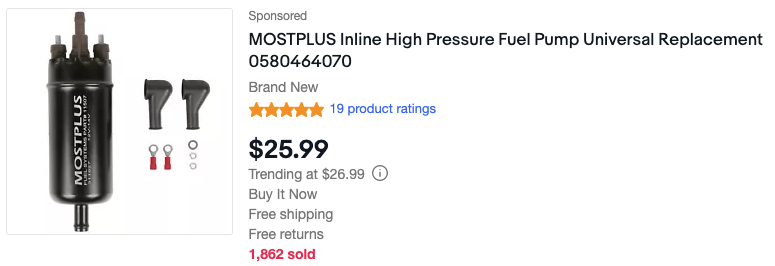Blog 2021/3/7
<- previous | index | next ->
In preparation for creating my own fuel injection system for a motorcycle, I am evaluating the most popular universal EFI fuel pump available on eBay (see my previous blog post).
In this test, I use a variable power supply to control an EFI fuel pump which is pumping into a hydraulic flow restrictor. The results are that I need about 5 Volts (26 Watts) to sustain 45 psi.
I also noted the voltage and current required to sustain a few other pressures:
- 20 psi requires 2.4 Volts and 2.5 Amps (6 Watts).
- 30 psi requires 3.7 Volts and 3.7 Amps (14 Watts).
- 40 psi requires 4.5 Volts and 4.8 Amps (22 Watts).
- 50 psi requires 5.3 Volts and 5.7 Amps (30 Watts).
- 60 psi requires 6.1 Volts and 6.8 Amps (42 Watts).
If you search eBay for part number "0580464070", a bunch of different brands of universal EFI fuel pumps will turn up for around $30. They all appear to be the same pump.
From an electrical load perspective, the pump can be thought of as a resistor of just under 1 Ohm. Note that this may not hold true for other flow requirements.
Flow restrictors of many different sizes are available from mcmaster.com:
A 0.02" hydraulic flow restrictor was chosen, as that roughly simulates the maximum flow requirement of my bike:
The test fluid being used is 1 gallon of ULTRA FLOW, a fluid used to calibrate fuel injectors:
I chose this fluid because it is supposedly less flammable than gasoline, which reduces the likelihood of burning down my apartment. It is available on eBay for $65 (search for "fuel injector calibration fluid"). The test fluid surprisingly does not have a strong odor. For comparison, the silicone spray I used to lube each of the brass barb fittings has a stronger smell.
The high-pressure fuel line is 5/16 / 8mm.
Spring clamps were used on the high-pressure side, but in an actual installation EFI-style screw clamps should be used for extra safety. 8mm ID hose presents an area of about 50 square mm to the pressure, or about 0.08 square inches, so at 45 psi the hose experiences a force of about 3.6 pounds trying to pull it off of the barb fitting.
The low-pressure fuel line is Tygon F-4040-A, available at mcmaster.com. Using under-sized Tygon makes a seal without the need for clamps (I used 1/4" Tygon on 5/16" brass barbed fittings, and 7/16" to interface with the 12mm fuel pump inlet). A 1/2" to 1/4" barbed brass reducer was used to adapt the inlet hose, but I should have used a 1/2" to 5/16" (note the clamp seen in the video).
All brass fittings were sealed with a few drops of blue thread locker. No drips so far. The cardboard would make drips visible and contain them.
The pressure transducer on the left isn't connected to anything yet, that's next!




